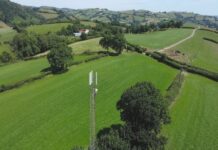Written by Chris Duller, Grassland Advisor for Farming Connect.
Chris Duller is an independent consultant specialising in delivering soil and grassland management advice across all of the livestock sectors.
As we move through February and day length extends, there is increasing potential for grass growth and an opportunity to apply readily available fertiliser nutrients to drive that early season growth. The attraction of early grass is always a strong one, with great possible rewards from an early turnout; both financially and in terms of labour.
The biggest issue with early season nutrient application is the uncertainty. Although February may be fair, we never know what March and early April have in store for us. It is very easy for investments made in early season fertiliser applications to be wasted, either in lost nutrients or poorly utilised grass.
The challenge for everyone is to manage the risks – to maximise the return on any investment and minimise the losses.
1) Timing.
When you venture out with nitrogen (N) fertilisers, it has to be driven by both soil conditions and the weather (current and the forecast). Soil temperatures should be above 5oC for a few days ahead of spreading. At 5oC, grass growth starts to kick in and soil bacteria are active; giving you a crop demand and a potential safety net to capture and hold the nitrogen. Soils need to be dry enough not to damage with traffic and a decent forecast of two or three dry days is vital.
2) Fertiliser options.
Urea is still my product of choice for very early applications when temperatures are low and soils are likely to be close to field capacity. In these conditions, the risks of nitrogen loss from ammonium nitrate as leaching are high. Last year was tricky for urea users with warm sunny conditions encouraging ammonia loss. Ideally, buy urea with an inhibitor to reduce losses. It may cost you an extra £35 a tonne – but it will reduce the risks enormously.
A source of readily available phosphate (P) is crucial for early season root growth. Therefore, if you are spreading on fields with low indexes (0, 1 and the lower end of index 2) then an NP product like 25:10:0 would be recommended (although supplies are limited).
What about sulphur? There is strong data available to support the method of inputting sulphur to improve nitrogen uptake.
3) Application rates.
With application rates, the earlier you go, the higher the risks, therefore, keep application rates below 25kgN/ha (20units/acre) through early February. You could increase the rate to 30kgN/ha by the end of the month and into early March. Don’t forget, response rates are likely to be less than 15kg grass DM/kgN applied. An Irish research study found only 21% of early season N application was recovered by grass.
4) Field choice.
One of the most important decisions for me is where you go with early season N application. Always think about minimising the risks and maximising the response. Avoid the old leys with low ryegrass levels, the north facing slopes, the fields that tested low for pH, and the heavier soils and any field with compaction issues. All of these can wait a few weeks when risks are lower. Beware spreading on very low grass covers, particularly with urea. A little grass cover offers some protection from both run-off and volatolisation – and root mass and N uptake is likely to be greater where you’ve got more leaf. Buffer zones are more important than ever for early season N application – give all water courses a wide berth, 5m at least.
The simple summary of the advice for early season N application is to be cautious, keep rates low, pick the right product and the right fields – and pay attention to the weatherman.
Farming Connect, which is delivered by Menter a Busnes and Lantra, has received funding through the Welsh Government Rural Communities – Rural Development Programme 2014-2020, which is funded by the European Agricultural Fund for Rural Development and the Welsh Government.
Help keep news FREE for our readers
Supporting your local community newspaper/online news outlet is crucial now more than ever. If you believe in independent journalism, then consider making a valuable contribution by making a one-time or monthly donation. We operate in rural areas where providing unbiased news can be challenging. Read More About Supporting The West Wales Chronicle
























